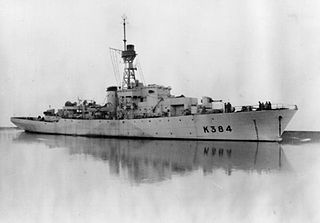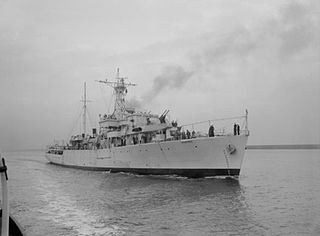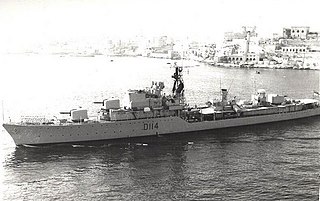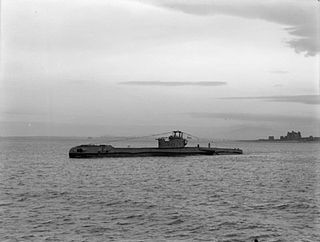
HMS Leeds Castle was a Castle-class corvette of the Royal Navy, originally with pennant number K384.

HMS Sidon was a submarine of the Royal Navy, launched in September 1944, one of the third group of S class built by Cammell Laird & Co Limited, Birkenhead, named after the naval bombardment of Sidon in 1840. An explosion caused by a faulty torpedo sank her in Portland Harbour with the loss of 13 lives.

HMS Tireless, a Taciturn- or T-class submarine, was the first ship of the Royal Navy to bear that name. She was authorized under the 1941 War Emergency Programme and her keel was laid down on 30 October 1941 at Portsmouth Dockyard. She was launched on 19 March 1943 and was completed on 18 April 1945.

HMS Forth, pennant number F04 later A187, was a submarine depot ship.

HMS Maidstone was a submarine depot ship of the Royal Navy. It operated in the Mediterranean Sea, Indian Ocean and Pacific Ocean during the Second World War. It was later used as a barracks ship and then a prison ship in Northern Ireland.

HMS Gambia was a Fiji-class light cruiser of the Royal Navy. She was in the service of the Royal New Zealand Navy (RNZN) as HMNZS Gambia from 1943 to 1946. She was named after the then Crown colony of the Gambia, and has been the only ship of the Royal Navy to bear the name.

HMS Artful (P456), was an Amphion-class submarine of the Royal Navy, built by Scotts Shipbuilding and Engineering Company of Greenock and launched 22 May 1944.

HMS Totem was a Group 3 T-class submarine of the Royal Navy which entered service in the last few months of World War II. To-date, she is the only ship of the Royal Navy to have been named Totem.
HMS Start Bay (K604/F604) was a Bay-class anti-aircraft frigate of the British Royal Navy, named for Start Bay in Devon. In commission from 1945 to 1946 in the Mediterranean Fleet, she spent most of her career in the Reserve Fleet.

HMS Surprise was a Bay-class anti-aircraft frigate of the British Royal Navy. In commission from 1946 to 1965, she served in the Mediterranean Fleet as a Despatch Vessel for the Commander-in-Chief. Although principally employed for the use as a yacht by the CinC, Surprise was also deployed in its operational role as an anti-aircraft frigate. The archaic term "Despatch Vessel" was replaced by "Flag Frigate" in 1961.

HMS Defender was a Daring-class destroyer of the Royal Navy.

HMS Rocket was an R-class destroyer of the Royal Navy that saw service during Second World War. Built by Scotts Shipbuilding and Engineering Company in Greenock, Scotland, she was launched in October 1942 and commissioned in August 1943.

HMS Wakeful was a W-class destroyer of the Royal Navy launched in 1943. She saw service during the Second World War and was later converted into a Type 15 fast anti-submarine frigate. She was sold for scrap in 1971.

HMS Tenacious was a T-class destroyer of the Royal Navy that saw service during the Second World War. She was built by Cammell Laird, of Birkenhead and launched on 24 March 1943.

HMS Scorcher was an S-class submarine of the Royal Navy, and part of the third group built of that class. She was built by Cammell Laird and launched on 18 December 1944. So far she has been the only ship of the Royal Navy to bear the name Scorcher. She was launched by Thomas Beacham, a Foreman Driller employed by Cammell Laird.

HMS Sea Devil was a S-class submarine of the third batch built for the Royal Navy during World War II. She survived the war and was sold for scrap in 1966.

HMS Token was a British submarine of the third group of the T class. She was built as P328 at Portsmouth Dockyard, and launched on 19 March 1943. So far she has been the only ship of the Royal Navy to bear the name Token.

HMS Teredo was a British submarine of the third group of the T class. She was built as P338 at Vickers Armstrong, Barrow and launched on 27 April 1945. So far she has been the only ship of the Royal Navy to bear the name Teredo, possibly after a mollusc, the shipworm, of that name.

HMS Mermaid was a Modified Black Swan-class sloop of the Royal Navy. Mermaid saw service as a convoy escort during the Second World War, taking part in the sinking of two German submarines while escorting Arctic convoys to and from the Soviet Union.

HMS Crispin was a C-class destroyer of the Royal Navy built by J. Samuel White, Cowes between 1944 and 1946. She was originally to have been named HMS Craccher. She was sold to the Pakistan Navy in 1958 and renamed PNS Jahangir. She was scrapped in 1982.




















